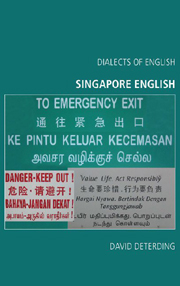5 - History and Current Changes
Published online by Cambridge University Press: 12 September 2012
Summary
Chapter 1 included a brief outline of the history of English in Singapore and an overview of language usage in Singapore. In this chapter, we will consider the history a little further, and also discuss variation in Singapore English and the ways in which it has been described. Finally, we will try to evaluate the ways in which Singapore English is currently evolving.
Recent history of English in Singapore
For most of Singapore's history, English was a minority language, used for official purposes such as in government offices and the law courts and mastered by a small elite, while the majority of the population spoke a variety of Chinese, Malay or Tamil. In 1957, just 1.8 per cent of the population used English as their first language, though of course many others were able to speak it to some extent (Bokhorst-Heng 1998). However, in the past five decades, the government has been actively promoting English, with the result that now virtually all young Singaporeans have a basic competence in the language and many compare well with the best in Britain or America. Furthermore, English is now the first language of a substantial number of people in Singapore. In the 2000 census, 35.8 per cent of Chinese children and 43.6 per cent of Indian children aged between five and fourteen were reported to be speaking English at home, though the language has made smaller inroads in the Malay community, with just 9.4 per cent of Malay children reported as using English as their home language.
- Type
- Chapter
- Information
- Singapore English , pp. 85 - 92Publisher: Edinburgh University PressPrint publication year: 2007



